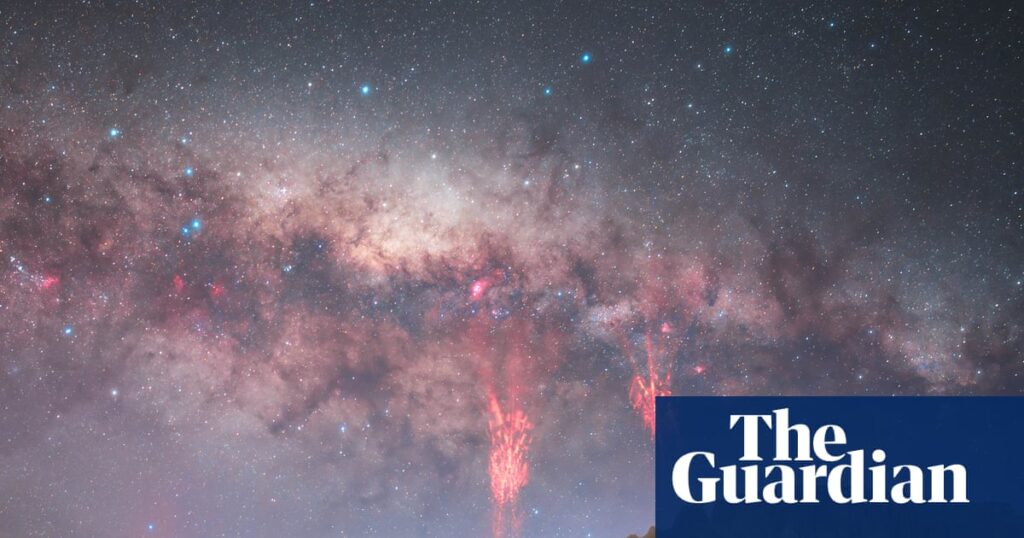
A group of photographers in New Zealand has captured the elusive “red sprites,” a rare atmospheric phenomenon where luminous crimson flashes appear in the sky. The event unfolded on October 11, as New Zealand photographer Tom Rae, alongside Spanish photographers Dan Zafra and José Cantabrana, set out to photograph the Milky Way over the Ōmārama Clay Cliffs on the South Island.
What began as a routine photography session quickly turned extraordinary. The photographers, initially hoping for clear skies, found themselves witnessing an unforgettable natural spectacle. “It was an unforgettable night,” Rae shared with the Guardian, describing the thrill of capturing the rare event.
The Science Behind Red Sprites
Red sprites are bursts of electrical energy that occur in the upper atmosphere, triggered by thunderstorms. Unlike conventional lightning, which travels towards the ground, red sprites shoot upwards, creating shapes that resemble columns, carrots, or jellyfish. First photographed accidentally in 1989 by a team at the University of Minnesota, these phenomena are fleeting, lasting only milliseconds, and are rarely visible to the naked eye.
Rae recounted his serendipitous observation of the red sprite. “I happened to be looking directly at one when it happened – just a perfect coincidence,” he said, describing the ethereal deep red flash that appeared in the sky.
Capturing the Unseen: A Photographer’s Dream
For Rae, an award-winning nightscape photographer, witnessing and capturing red sprites was a dream come true. “It looks like you’re seeing something that is not real, it’s very ethereal,” he explained. The challenge lies in the technical mastery required to capture such phenomena, combining scientific understanding with creative flair.
Dan Zafra echoed Rae’s sentiments, describing the night as one of the “most extraordinary” of his life. “I could see the Milky Way glowing above the horizon while these enormous red tendrils of light danced above a storm hundreds of kilometers away,” Zafra said. To his knowledge, no other images exist that capture red sprites alongside the southern hemisphere Milky Way in a single frame.
“It was one of those moments when you know you’re witnessing something you’ll probably never see again,” Zafra remarked.
The Rarity and Significance of Red Sprites
The rarity of red sprites makes them a coveted subject for photographers and scientists alike. These phenomena provide insights into atmospheric electricity and the dynamics of thunderstorms. Despite their brief appearance, red sprites offer a glimpse into the complex interactions occurring in the upper atmosphere.
Capturing such an event requires not only technical skill but also a bit of luck. As Rae noted, “It’s a really involved type of photography that’s very rewarding as well.” The photographs taken by Rae, Zafra, and Cantabrana serve as a testament to their dedication and expertise in the field of nightscape photography.
Implications for Atmospheric Research
The documentation of red sprites contributes to ongoing research in atmospheric science. Understanding these phenomena can aid in the study of electrical activity in storms and its impact on the upper atmosphere. Researchers continue to explore the conditions that lead to the formation of red sprites, seeking to unravel the mysteries of this captivating natural occurrence.
As the photographers reflect on their experience, the images they captured stand as a reminder of nature’s unpredictable beauty and the endless possibilities that lie within the night sky. The event not only enriched their personal portfolios but also added valuable data to the scientific community’s understanding of atmospheric phenomena.
In the realm of photography and science, the capture of red sprites over New Zealand’s skies marks a significant achievement, one that highlights the intersection of art, nature, and scientific inquiry.





